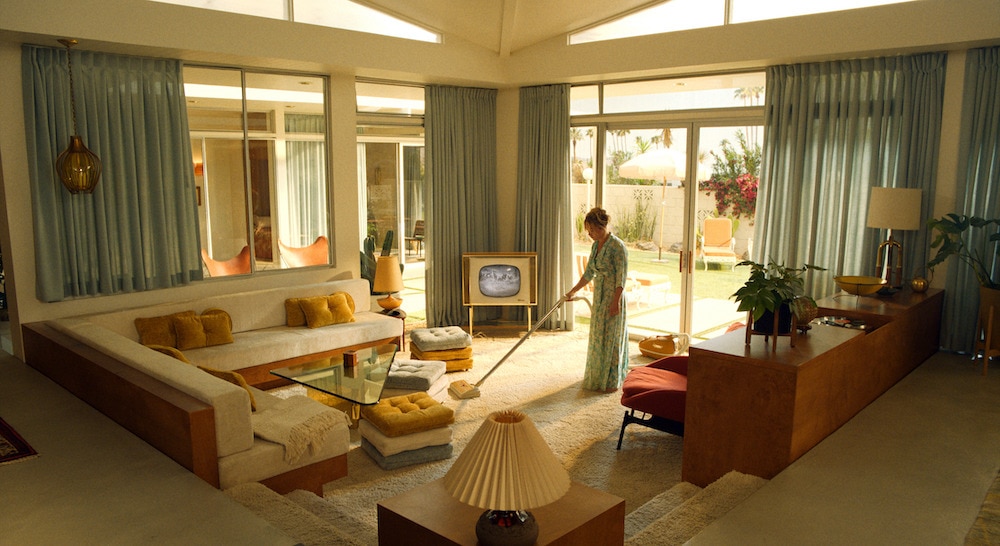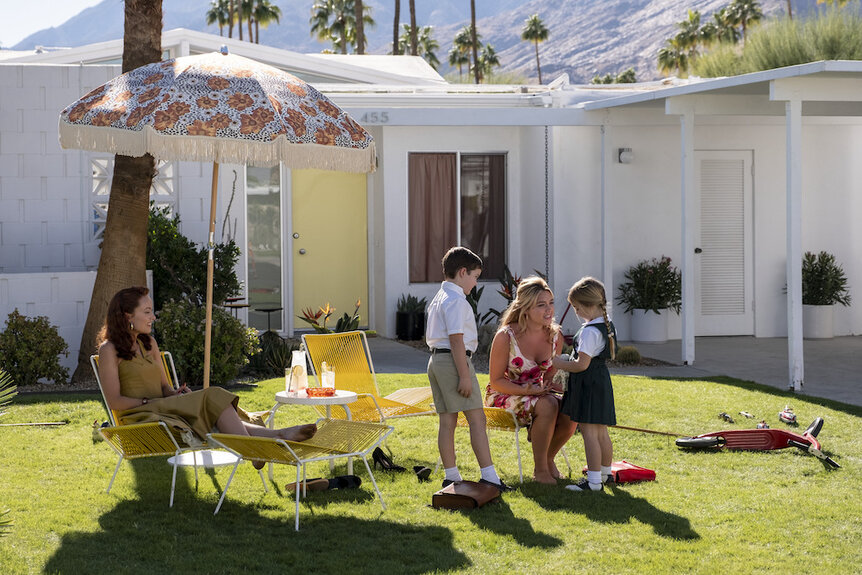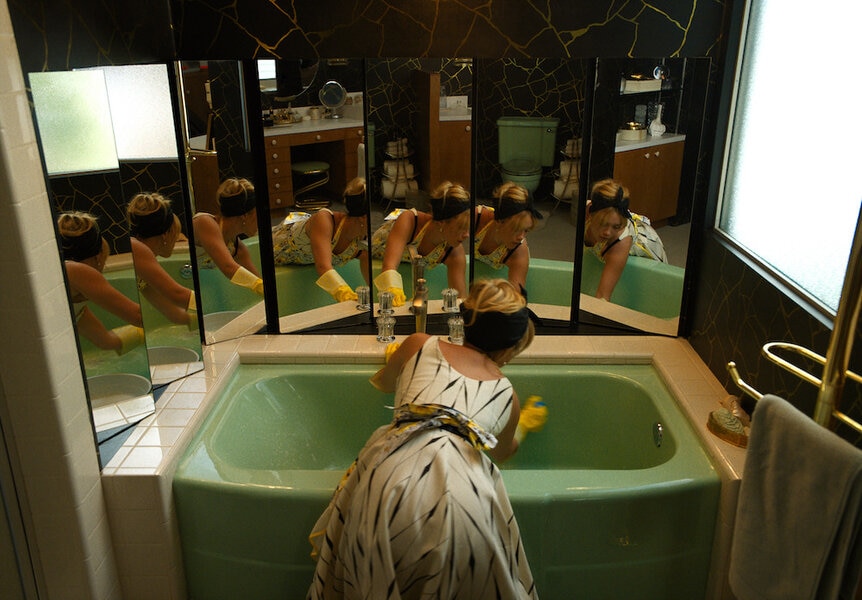Create a free profile to get unlimited access to exclusive videos, sweepstakes, and more!
'Don't Worry Darling' production designer built a sinister 'acid trip' through 1950s suburbia
Don't Worry Darling is now playing in theaters everywhere.

There's something fishy in the Nifty '50s in Don't Worry Darling, Olivia Wilde's second directorial effort. Set in the idyllic and remote California desert town of Victory, the film explores the bubbling disillusionment of dutiful housewife Alice (Florence Pugh), who begins to wonder whether her Eisenhower-era existence with British husband Jack (Harry Styles) is a little too good to be true. The cars are sleek, the homes are well-kept, there's a sizzling roast in every pot, and credit limits simply don't exist. All the women of this community have to do is sit back, relax, dote on their husbands, and ask no questions about the mysterious Victory Project headed up by the enigmatic Frank (Chris Pine).
***WARNING! The following contains major plot spoilers for the film, particularly its ending!***
"We were exploring ideas of questioning systems in place that are destructive, but comfortable, to a fraction of society," the film's production designer Katie Byron (who previously worked with Wilde on the director's feature debut, 2019's Booksmart), tells SYFY WIRE over email. "How we may have to be bold and courageous — humanity as a whole — to leave a toxic system behind. I think a lot about how capitalism, colonialism, and the patriarchy are very difficult ontological systems to dissolve. With this philosophy, we knew that the world-build for Don’t Worry Darling was crucial and needed to be as lush and dazzling as possible. I saw it as a seductive, kaleidoscopic, glistening place."
Wanting to capture the "progressive design aesthetic" of the time period, Byron drew inspiration from a number of mid-20th century architects who "were pushing the envelope" like Rudolph Schindler, Albert Frey, John Lautner, Richard Neutra, and Alexander Girard. The production designer singles out Neutra as her "architectural hero" and "a true trailblazer for desert modernism" that drives the oasis-like aesthetic of Victory. "He referred to himself as a 'biorealist' and held a very specific philosophy about man, nature, and architecture," she explains, going on to add that the production didn't want to be pigeonholed into the traditional vision of '50s suburbia.
"The cookie-cutter vision of 1950s utopia seen in advertisements and television is one that is sold to us, but the 1950s was not tied to one singular aesthetic in the same way that there’s not one singular look to 2023. We were excited to find cutting-edge design in the 1950s and feature it ... Victory, which is a progressive community built in the desert, is pushing the bounds, so I thought the architecture should too. We aimed to create this totally sensual world full of opulence and debauchery."
Neutra's work served as the main foundation for the interior of Jack and Alice's home, which "meant that the house had quite a bit of storage in the design," Byron says. "In the hallway, there is a closet you never see in the film that is stocked with cleaning equipment and linens. In the bedroom, there is a walk-in closet filled with clothing. In the living room, the drawers are filled with various card games, and excess candles. We even dressed a junk drawer! You never get to see this as a viewer, but we dressed these details to make the place feel real to the actors and to inspire any improv."
Given the fact that the movie centers around a woman named Alice falling down a proverbial rabbit hole that forces her to question the very nature of reality, it was only fitting that Lewis Carroll would factor into the equation at some point "Alice: Through the Looking Glass is also a big reference for us," Byron reveals. "When designing the house full of glass, colored glass, [and] crystal mirrors, we wanted to create a place that challenged perception — for Alice, but also the viewers."
She later continues: "The [main] thing I wanted to play with is that our understanding of how a space can change with the circumstance and emotion around it. To have the house first function as an opulent jewel box and then morph into something more menacing. The glass is luminous at first and then threatening. The textures of the stone, brick, and concrete are sleek and tactile and then it becomes brittle and dangerous."
Gaslit and belittled to no end by her friends and the powerful men of the community, Alice is finally vindicated in the film's climax, where we learn that the town of Victory is nothing more than a fictional simulation. Alice has been held captive in the '50s-inspired reality by Jack, who was tired of living a humdrum existence in the real world.
"Since our world of Victory was so stylized, we felt like we could also push the real world into a bit of a stylized direction," Byron says. "I’ve always wanted to have a shot at designing a Gotham and playing with how murky things can get. I imagined that coming from Victory to the present would be like coming down from an acid trip. Where the colors fade and you start to see the grime reappear. We added rain and a wet down to create a feeling of saturation through contrast instead of color."
We do get a few brief glimpses at Jack and Alice's contemporary apartment, which makes use of "muted greens, brown and black," the production designer adds. "I imagined their apartment looking like a wilted flower. The bedroom was a heavy scenic application by our [paint supervisor] Adrian Valdes. He took a brighter purple and through many layers of darker color washes and achieved something that felt sultry, but decayed. The bedroom was then decorated with ethereal and rustic furniture and crystal lamps. We wanted to achieve a sense of sweetness here. A somber sorrow of the present."
She concludes: "In the modern world exterior scene, there is a neon sign that you barely see that says 'Past Present Future Can Help You Now.' We loved this as a sign to indicate a merging of planes of existence. There is a 6-foot tall cinema poster for [the] James Bond [film] From Russia With Love in the modern apartment as a subtle nod to Jack being an anglophile and why he chose the accent he did in the film."
Don't Worry Darling is now playing in theaters everywhere.
Looking for more thrillers? Peacock has films like The Black Phone, The Mummy trilogy, and more streaming now.




























